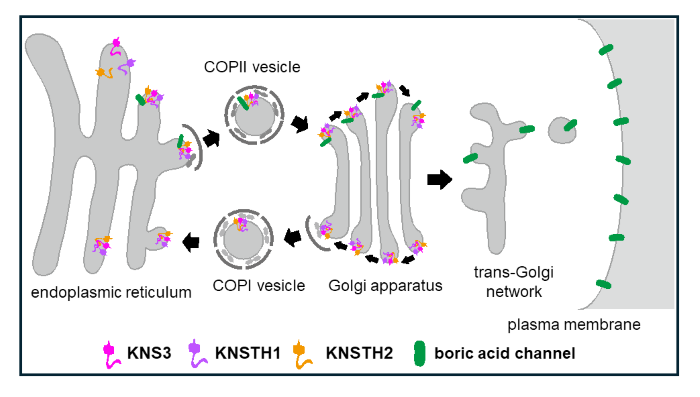Research News
Oct 30, 2024
- Agriculture
Spirited away: key protein aids transport within plant cells
Arabidopsis thaliana mutant’s lack of KNS3 means boric acid channels don’t arrive properly at plasma membrane
How boric acid channels make their way to the plasma membrane
The KNS3-KNSTH1-KNSTH2 complex acts as a cargo receptor for the transport of boric acid channels from the endoplasmic reticulum to the plasma membrane.
Credit: Osaka Metropolitan University

Botanists have come to understand the channels and transporters involved in the uptake and transport of nutrients, yet how are they positioned where they need to be?
For example, plants need boron, which is taken into the cells by molecules known as the boric acid channel. But how do the proteins that form the channel make it to the plasma membrane?
A research group led by Professor Junpei Takano of Osaka Metropolitan University’s Graduate School of Agriculture identified a mutant line of Arabidopsis thaliana in which the boric acid channels are not properly transported to the plasma membrane. The cause was a deficiency in the protein KAONASHI3 (KNS3); the name kaonashi (Japanese for “faceless”) was given in 2008 by a research team under Nagoya University Associate Professor Sumie Ishiguro, who is also an author of the current study.
Detailed examination of the transport process of boric acid channels revealed that KNS3 and homologue proteins dubbed KNSTH1 and KNSTH2 are likely to form a protein complex. These complexes help move the boric acid channels from the endoplasmic reticulum to the Golgi apparatus, then to the plasma membrane.
In addition, the pollen of Arabidopsis thaliana usually has a surface with patterns like muskmelon skin, but this pattern disappears—becomes faceless—in mutant strains that lack the protein-encoding function of the KNS3 gene, which is involved in pollen exine formation. This feature might be due to abnormal transport of a protein other than that for the boric acid channel.
“Based on the mechanism of intracellular transport of membrane proteins revealed in this study, plants might regulate nutrient uptake and pollen structure by regulating the intracellular transport of specific proteins via the KNS3-KNSTH1-KNSTH2 complex,” stated Professor Takano. “Our results might help uncover ways to reduce fertilizer requirements while improving crop yields.”
The findings are published in the Journal of Experimental Botany.
Funding
This work is supported by JSPS Grant-in-Aid (16K15082, 19H05763, 19H00934) and NEXT program (GS001) to J.T. and JSPS Grant-in-Aid (19H05637) to T.F.
Paper information
Journal: Journal of Experimental Botany
Title: Arabidopsis KNS3 and its two homologs mediate endoplasmic reticulum to plasma membrane traffic of boric acid channels
DOI: 10.1093/jxb/erae380
Authors: Zhe Zhang, Shunsuke Nakamura, Arisa Yamasaki, Masataka Uehara, Shunsuke Takemura, Kohei Tsuchida, Takehiro Kamiya, Shuji Shigenobu, Katsushi Yamaguchi, Toru Fujiwara, Sumie Ishiguro, Junpei Takano
Published: 30 October 2024
URL: https://doi.org/10.1093/jxb/erae380
https://academic.oup.com/jxb/advance-article/doi/10.1093/jxb/erae380/7841954?searchresult=1
Contact
Graduate School of Agriculture
Email: jtakano[at]omu.ac.jp
*Please change [at] to @.
SDGs
